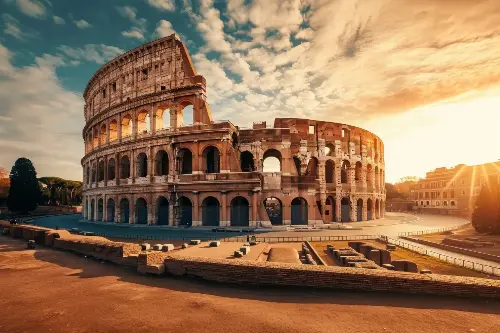
As the sun kisses the horizon in Rome, casting golden hues over ancient stones, there's no denying the magnetic pull of the Colosseum. This iconic amphitheater, a testament to the grandeur and ingenuity of ancient Roman architecture, continues to captivate visitors from around the globe. But what is it about this colossal structure that so deftly ensnares the modern imagination?
Firstly, consider its mammoth scale. When the Colosseum was completed in 80 AD, it was the largest amphitheater of its time, capable of seating between 50,000 to 80,000 spectators. Within its elliptical structure, spanning 189 meters in length and 156 meters in width, with a height of 48 meters, one can only marvel at the capability of architecture that could accommodate entire towns' worth of people two millennia ago. Such figures and dimensions speak volumes about the ambition and engineering prowess of the Romans.
Beyond its size, the Colosseum's design showcases the elegance of ancient Roman engineering. It features a complex system of vaults constructed with precision from travertine, tuff, and brick-faced concrete. The building once sprouted with statues that adorned the arches on its upper floors, gifting it with not just stature, but an ornamental beauty that has long since been a whisper from the past. Yet, despite the ravages of time, the remaining structure reflects a time when aesthetics and function went hand in hand, creating not just a place for games but a landmark of artistic expression.
The allure of the Colosseum also lies in the layers of history etched into its walls. It was a place of grand spectacles: gladiatorial combat, animal hunts, and mock naval battles, known as naumachiae. The amphitheater provided Rome with a theatre for demonstrations of power and control, entertainment, and a place for social interaction across the strata of ancient Roman society. The very stones of the Colosseum have borne witness to human drama on an epic scale.
But beyond the bloodshed and spectacle, the Colosseum stood as a symbol of imperial Rome. Built under the Flavian emperors, this great arena remains a monument to the Roman Empire's vast power and reach, acting simultaneously as a microcosm of the empire at large. Even today, it represents a connection to our collective past, embodying over two thousand years of human history.
Visitors today continue to be awed by the Colosseum's hypogeum, the underground complex beneath the arena floor, where gladiators and animals were once held before they lifted into the arena via ingeniously designed elevators and trapdoors. This subterranean maze provides a haunting glimpse into the practicalities of orchestrating the grand events that would unfold above.
The architectural ingenuity is further accentuated when considering the Colosseum's resilience. Despite suffering through earthquakes, stone robbers, and the inexorable march of time, the Colosseum stands proudly, a resilient symbol amidst the ever-changing cityscape of Rome. It is this enduring nature that also serves as a metaphor for the city itself: despite all, Rome endures.
In exploring the Colosseum, one not only traverses a physical landscape but also a rich narrative of cultural and architectural evolution. It represents a phenomenal example of urban planning, reflecting the Roman's advanced understanding of crowd control with its multitude of entrances and exits, now known as 'vomitoria,' allowing for the rapid dispersal of crowds.
As we observe the Colosseum in the context of its time, it's not hard to draw parallels with modern stadiums and arenas. The principles of design and crowd management, the drive to impress and control, the thirst for communal entertainment—all these are echoes of the human spirit that remain consistent through the ages.
In essence, the Colosseum is a bridge between the ancient and modern worlds, a place where history is tangible and the shadows of the past come to life. As we walk in the footsteps of those who came before, we are reminded of the incredible advancements in architecture and society accomplished by the Romans, the vestiges of which continue to inform and inspire our own civilization.
So next time you stand in the echoing expanse of Rome's greatest amphitheater, take a moment to appreciate not just the grandeur of its arches or the vastness of its arena, but the relentless pulse of human history that resonates through its enduring stones. In the Colosseum, ancient Rome's architecture speaks to us across the ages, reminding us that within these ruins lies the story of us all.
